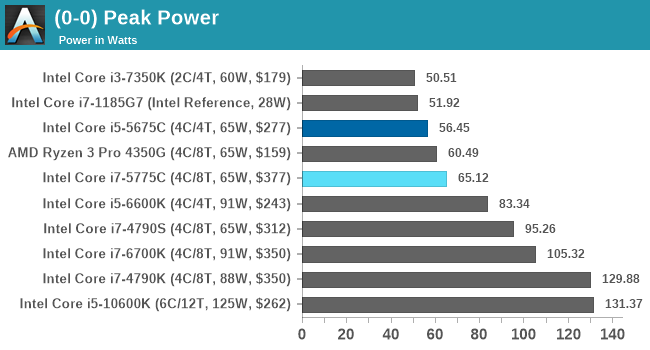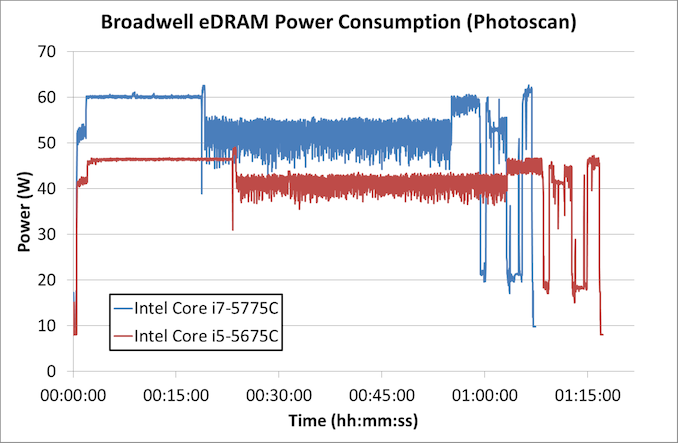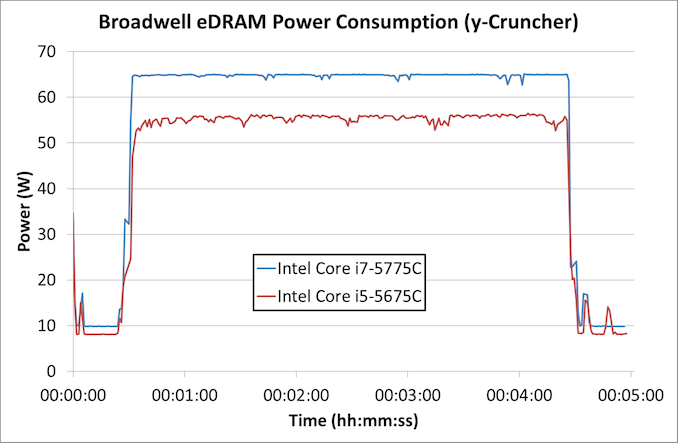A Broadwell Retrospective Review in 2020: Is eDRAM Still Worth It?
by Dr. Ian Cutress on November 2, 2020 11:00 AM ESTPower Consumption
The nature of reporting processor power consumption has become, in part, a dystopian nightmare. Historically the peak power consumption of a processor, as purchased, is given by its Thermal Design Power (TDP, or PL1). For many markets, such as embedded processors, that value of TDP still signifies the peak power consumption. For the processors we test at AnandTech, either desktop, notebook, or enterprise, this is not always the case.
Modern high performance processors implement a feature called Turbo. This allows, usually for a limited time, a processor to go beyond its rated frequency. Exactly how far the processor goes depends on a few factors, such as the Turbo Power Limit (PL2), whether the peak frequency is hard coded, the thermals, and the power delivery. Turbo can sometimes be very aggressive, allowing power values 2.5x above the rated TDP.
AMD and Intel have different definitions for TDP, but are broadly speaking applied the same. The difference comes to turbo modes, turbo limits, turbo budgets, and how the processors manage that power balance. These topics are 10000-12000 word articles in their own right, and we’ve got a few articles worth reading on the topic.
- Why Intel Processors Draw More Power Than Expected: TDP and Turbo Explained
- Talking TDP, Turbo and Overclocking: An Interview with Intel Fellow Guy Therien
- Reaching for Turbo: Aligning Perception with AMD’s Frequency Metrics
- Intel’s TDP Shenanigans Hurts Everyone
In simple terms, processor manufacturers only ever guarantee two values which are tied together - when all cores are running at base frequency, the processor should be running at or below the TDP rating. All turbo modes and power modes above that are not covered by warranty. Intel kind of screwed this up with the Tiger Lake launch in September 2020, by refusing to define a TDP rating for its new processors, instead going for a range. Obfuscation like this is a frustrating endeavor for press and end-users alike.
However, for our tests in this review, we measure the power consumption of the processor in a variety of different scenarios. These include full AVX2/AVX512 (delete as applicable) workflows, real-world image-model construction, and others as appropriate. These tests are done as comparative models. We also note the peak power recorded in any of our tests.

In peak power, the Core i7-5775C sticks to the 65 W value, whereas the Core i5 variant is below its TDP value. This is beyond the 22nm Core i7-4790S which is also a 65 W part.
In real-world tests, first up is our image-model construction workload, using our Agisoft Photoscan benchmark. This test has a number of different areas that involve single thread, multi-thread, or memory limited algorithms.
For Photoscan, the Core i7 spends its 'real world' time around 60 W, but does momentarily spike up above that 60 W mark. The Core i5 by comparison doesn't even touch 50 W.
The second test is from y-Cruncher, which is our AVX2/AVX512 workload. This also has some memory requirements, which can lead to periodic cycling with systems that have lower memory bandwidth per core options.
We're seeing some slight variation in power as the y-Cruncher algortihm moves out to DRAM movement over compute, however both processors seem to be hitting either their power limits or just a natural peak power consumption.












120 Comments
View All Comments
Jorgp2 - Monday, November 2, 2020 - link
Why didn't he buy it then?There was even a many lake refresh
Oxford Guy - Wednesday, November 4, 2020 - link
He didn’t buy a desktop high TDP Skylake with EDRAM because it was never produced. Intel decided to sell less for more, which it could so safely since our capitalist system is mainly about a near-total lack of competition far more often (in tech at least) than anything else. Read for comprehension.Oxford Guy - Monday, November 2, 2020 - link
So, the take-away here is that Intel was heavily sandbagging — not bothering to take advantage of the benefit EDRAM provides (for gaming especially).$10 worth of parts and gamers were expected for fork over big money for less performance.
Hooray for lack of competition.
Nictron - Tuesday, November 3, 2020 - link
My i7 5775c died last week after 4.5 years of service at OC 4.1-4.2 Ghz. Now seeing this review I am quite sad as it could’ve gone a bit more.Upgraded to R5 3600XT for now and can always go 5000 series in future on the X570 platform.
Hope competition stays strong!
Oxford Guy - Wednesday, November 4, 2020 - link
You can hope or you can look at the facts. It hasn’t been strong. That’s why Intel was able to sandbag so extremely.alufan - Tuesday, November 3, 2020 - link
The Intel skew on this site is getting silly its becoming an Intel promo machine!You Benchmark but like many Laptop providers you hamstring the AMD CPU with the worst and slowest components, we all know Ryzen CPUs work best with fast RAM in fact you have stated so yourselves in the past on this very site yet you now choose to test the Ryzen option with CL22 bargain basement RAM..... makes me wonder, how much did Intel pay for this review of a 5 year old CPU just to keep the Blue option at the top of the page, Anandtech is a shameful parody of a neutral review site and frankly the owners and editors have exchanged integrity for well whatever you want to call it, shame on you
Ian Cutress - Tuesday, November 3, 2020 - link
I test at JEDEC speeds. For Ryzen that's DDR4-3200, and JEDEC subtimings are CL22. If you want to complain, complain to JEDEC to ask for something faster, or ask companies to validate memory controllers beyond JEDEC standards. Otherwise it's overclocking, and if we're overclocking, then who cares about core frequency or power anyway.https://www.youtube.com/watch?v=jQe5j7xIcog - I even did a video on it.
I do tons of AMD coverage. Year in year out interviews of CEO and CTO of AMD, but no equivalent of Intel. Deep dives into every major architecture, with analysis of instruction performance as well as cache hierarchy. Reviews of almost every single Ryzen product, as we're sampled most of them. If we were that big of an Intel shill, why does AMD supply us what we ask for?
alufan - Tuesday, November 3, 2020 - link
Ahh so the Ram kit you used for the Intel test just happened to fall into the slots then with its CL16 is that JEDEC standard?I dont want any particular preference shown to either Brand I will admit however to not liking Intel due to former poor experience but I think its important when charts and such are published that a level field is used, because at some point somebody may well use those published figures as a illustration of one products superiority over another, Intel is very good at doing just that, and I will cite the last Thread ripper release for that one just so they could have a set of tables showing the Intel product on the Top even if it was for a few hours.
qwertymac93 - Tuesday, November 3, 2020 - link
Where did you find the latency settings the tests were performed at? I didn't see the latencies mentioned in the test setup page.alufan - Tuesday, November 3, 2020 - link
"Where did you find the latency settings the tests were performed at? I didn't see the latencies mentioned in the test setup page."look up the parts on the makers website